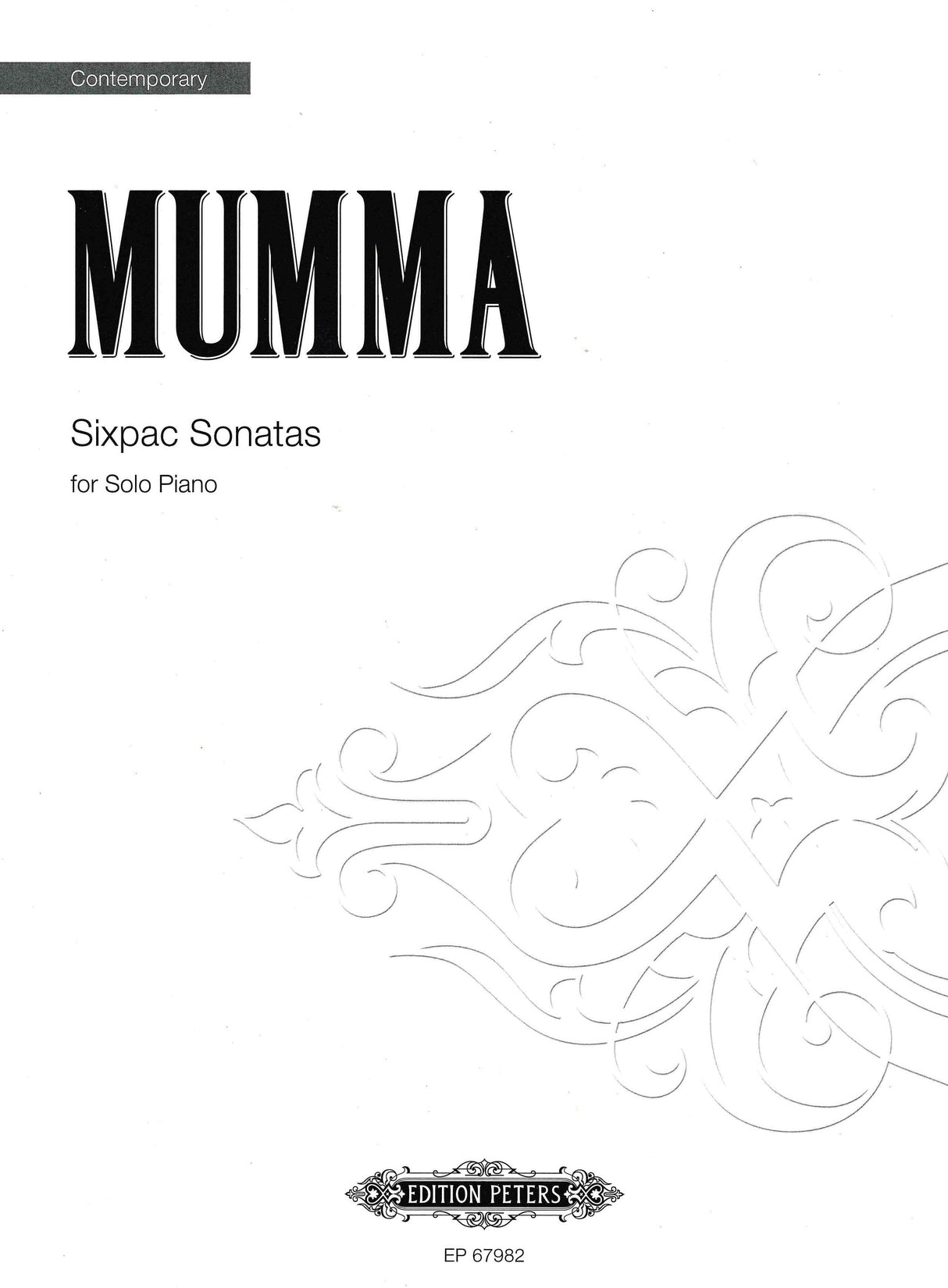Gordon Mumma
Mumma: Sixpac Sonatas
- Composer: Gordon Mumma (1935-)
- Instrumentation: Piano
- Work: Sixpac Sonatas
- ISMN:
- Size: 9.1 x 11.9 inches
- Pages: 24
Description
The Sixpac Sonatas began with an invitation in 1985 to contribute a short composition to a Festschrift for musicologist H. Wiley Hitchcock (Sonata No. 1). A structure based on that of Domenico Scarlatti's harpsichord sonatas or John Cage's Sonatas and Interludes for prepared piano was deemed appropriate for this scholar of eighteenth-century music. The template idea took hold, eventually expanding into six sonatas, the last of which (no. 6) was completed in 1997. Some are formally strict, consisting of a repeated A and B section with coda derived from the material of the previous sections; others feature continual variation of the musical material interspersed with contrasting fragments. All are notated in measures of five eighth-note valueswithout meter signature as a means of establishing pulse without the habitual practice of rig-idly accented downbeats. Metronome markings refer to the eighth notes, and are approximate landmarks in a continuity of discretely flexible tempos.
The Sixpac Sonatas are playable on any keyboard instrument, whether modern piano, fortepiano, or harpsichord; their four-octave range accommodates historical keyboards. The dy-namic indications refer to both hands when centered between the staves, or to a single hand or musical line when placed accordingly. in the absence of dynamic variation when these sonatas are played on the harpsichord, greater liberty with tempo variation may be appropriate. The expressive possibilities should be understated in performance, particularly on the piano.
With the exceptions of the earlier Sonata No. 1, the Sixpac Sonatas use only-flats as chromatic alterations. Accidentals apply only to the pitch that they immediately precede within that register and within that single measure. By applying this rule-of-thumb, the performer should attain the expected reading. Nevertheless ambiguities required the modest addition of cautionary accidentals, notably in passages where an inflected and uninflected version of thsame pitch appear in different ranges either simultaneously or in very close proximity within a single musical gesture.
The dedications also include Julia Wilson Jones (an architect from London), Homer Keller (composer and teacher), and David W. Bernstein (theorist-musicologist). My thanks to Michelle Fillion for her assistance in preparing this edition. The Sixpac Sonatas may be consumed in any order or quantity, as the performer chooses.
Publishers use a lot of words to describe what they sell, and we know it can be confusing. We've tried to be as clear as possible to make sure you get exactly what you are looking for. Below are descriptions of the terms that we use to describe the various formats that music often comes in.
Choral Score
A score for vocalists that only contains the vocal lines. The instrumental parts are not there for reference. Generally, cheaper than a vocal score and requires multiple copies for purchase.
Facsimile
Reproductions of the original hand-written scores from the composer.
Full Score
For ensemble music, this indicates that the edition contains all parts on a single system (there are not separate parts for each player). In larger ensembles, this is for the conductor.
Hardcover
Hardbound. Generally either linen-covered or half-leather.
Orchestral Parts
Similar to a wind set, this is a collection of parts. In the case of strings, the numbers listed are the number of copies included, though generally these are available individually (often with minimum quantities required).
Paperback
When publishers offer multiple bindings (e.g. hardcover) or study scores, this is the "standard" version. If you're planning to play the music, this is probably what you want.
Performance / Playing Score
A score of the music containing all parts on one system, intended for players to share. There are not separate parts for each player.
Set of Parts
For ensemble music, this indicates that there are separate individual parts for each player.
Solo Part with Piano Reduction
For solo pieces with orchestra, this is a version that contains a piano reduction of the orchestra parts. For piano pieces, two copies are typically needed for performance.
Study Score
A small (think choral size) copy of the complete score meant for studying, and not playing. They make great add-ons when learning concertos and small chamber works.
Vocal Score
A score prepared for vocalists that includes the piano/organ part or a reduction of the instrumental parts.
Wind Set
For orchestral music, this is a collection of wind and percussion parts. The specific quantities of each instrument are notated.
With Audio
In addition to the printed music, the edition contains recordings of the pieces. This may be an included CD, or access to files on the internet.
With / Without Fingering (Markings)
Some publishers prepare two copies - a pure Urtext edition that includes no fingering (or bowing) suggestions and a lightly edited version that includes a minimal number of editorial markings.




